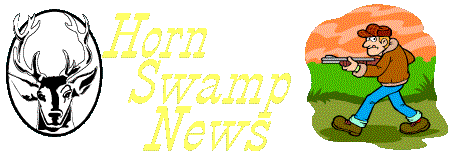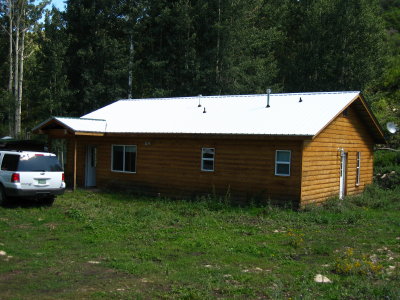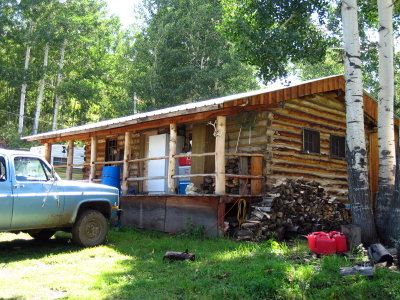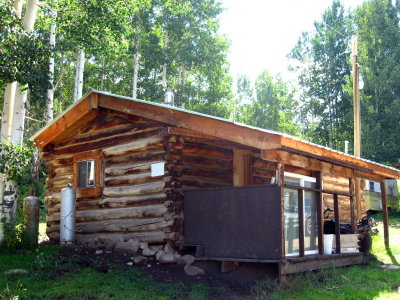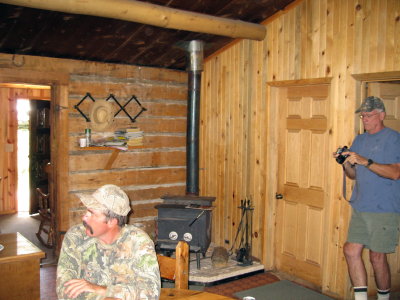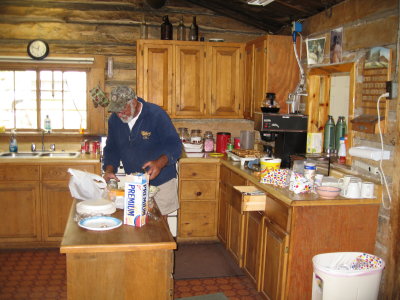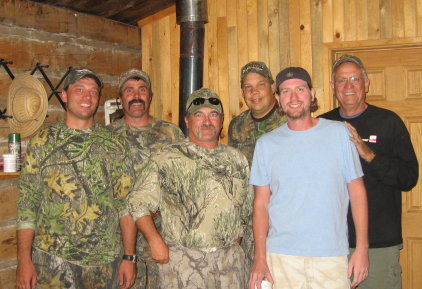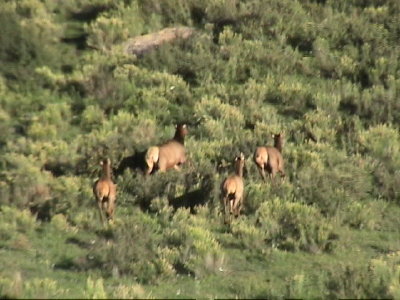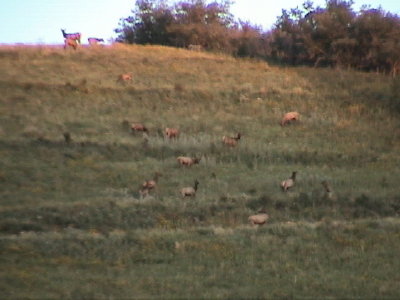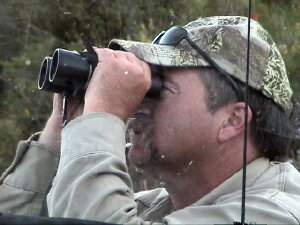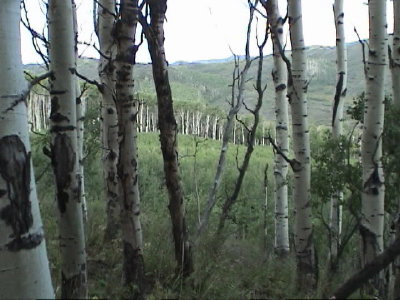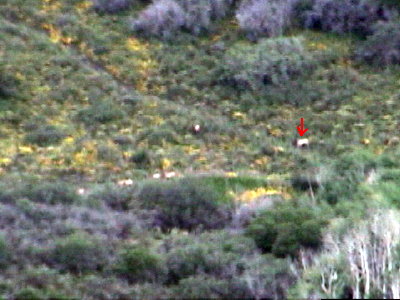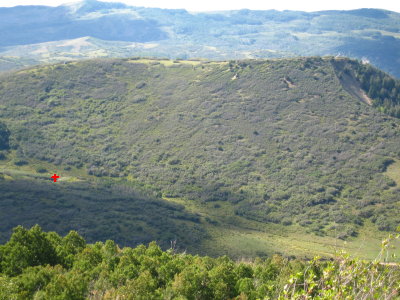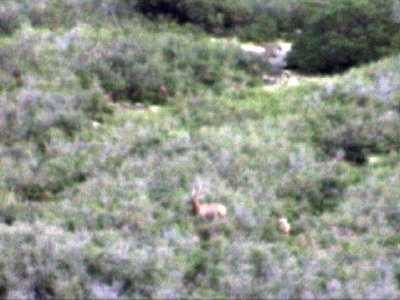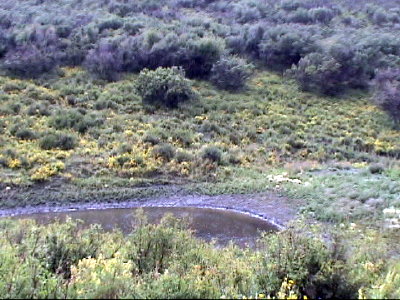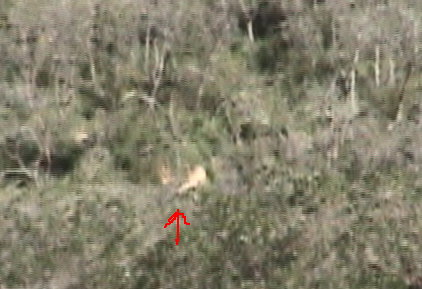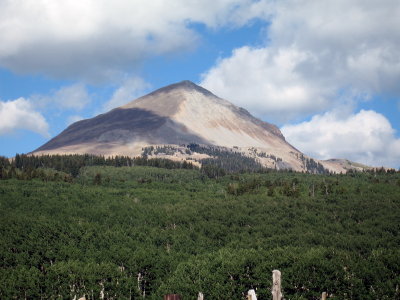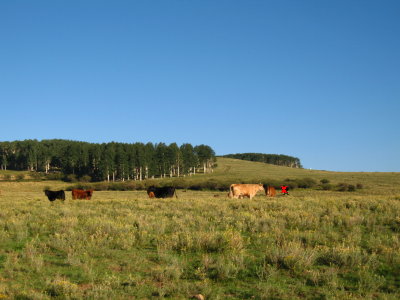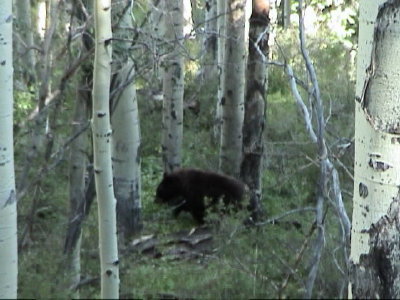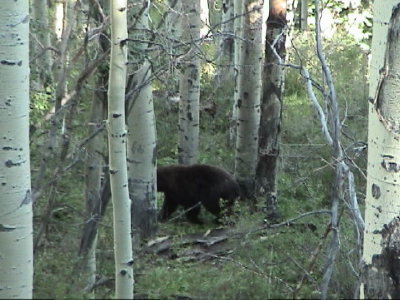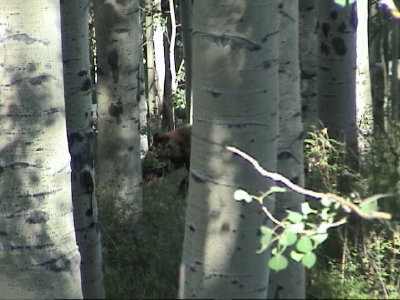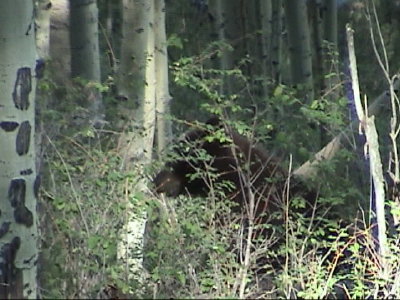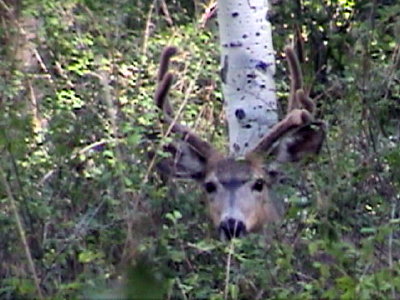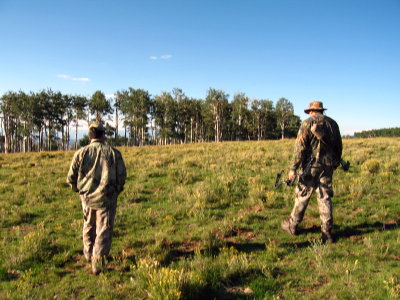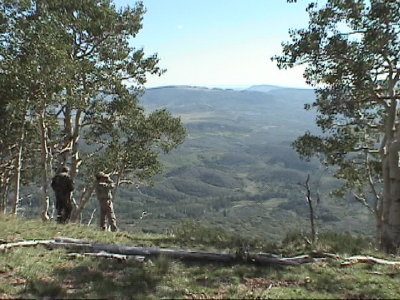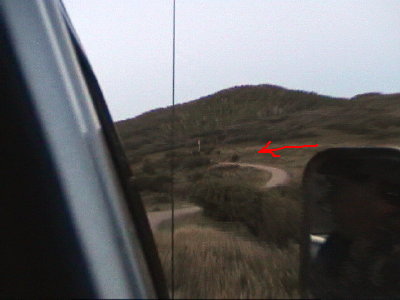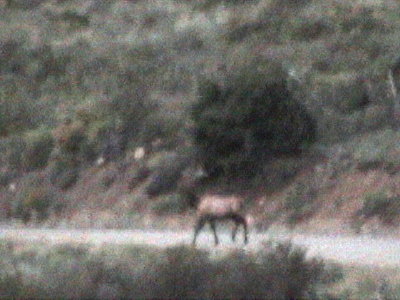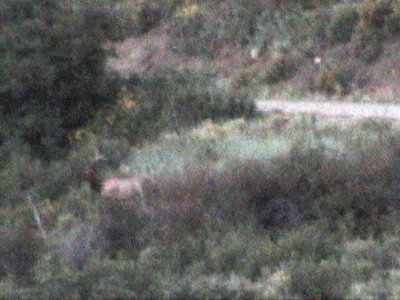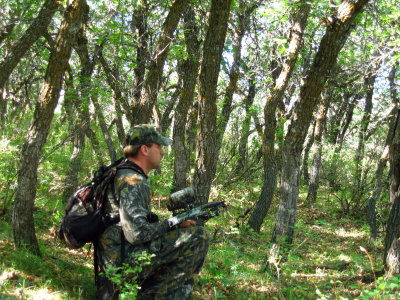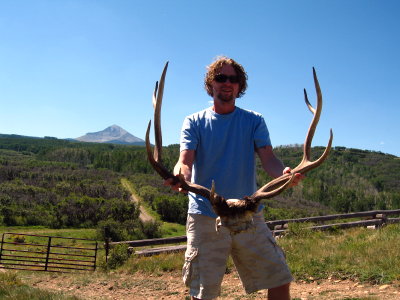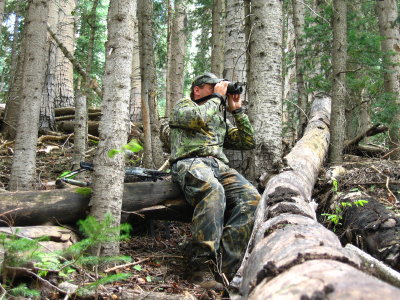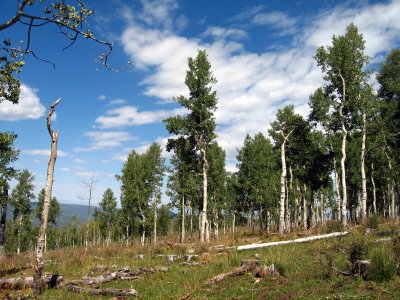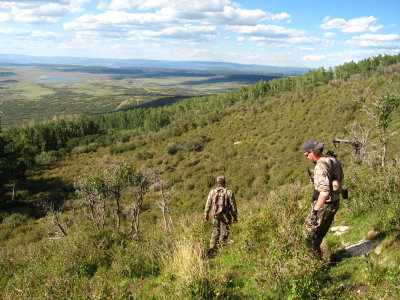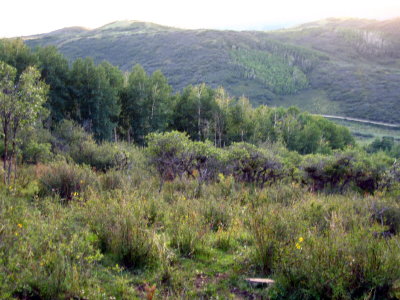SPECIAL FEATURE
COLORADO ELK HUNT 2006
Updated
10/01/06 at 07:00AM, CST
We left Camden in the early hours of Friday morning, August 25th in route to Mobile to catch a flight to Montrose, CO, via Houston. Our hunting party, my uncle Bud Selsor, his son Wade, and friend, Robbie Hines from Atlanta, arrived in Montrose around 10:30 AM Friday morning. After loading our gear into the rental car we stopped by a outdoor store to buy our "over the counter" archery "either sex" elk tags. We then drove an hour an a half south of Montrose, through the little town of Norwood and south to the base of Lone Cone Mountain. Bud and Wade had hunted this area last September on a friend's property. This time we would be hunting with an outfitter whose land adjoins the property where they hunted last year.
After arriving at the cabins that would be home for the next six nights, we unpacked the bag target we had shipped out and set out to make sure our bows were still shooting correctly. For whatever unknown reason mine was shooting a good 4-6" high at 20 and 30 yards so an adjustment was necessary. Wade had the same problem with his bow. We were thankfully prepared to quickly adjust the sights. I still can't understand what changed in the course of our travel that made this necessary.
Our camp consisted of three cabins on the side of Lone Cone Mountain at an elevation of 8500 feet. The original log cabin was a trapper's line cabin that was built pre 1900. It had been enlarged a bit and was used as bunk rooms for guides. The main cabin, another log structure, was originally constructed in 1930. It had been enlarged in recent years as well. This cabin had two bedrooms, a bath, a large kitchen and a dining area and is where we ate our meals. Our cabin sat up the hill a few feet and was about 3 years old. It had two bunkrooms, two bedrooms, a kitchen, den, and bathroom facilities. It even had central heat and a TV with satellite reception! We were not roughing it by any means.
Lone Cone Mountain and its peak in the distance. This is the eastern slope that we hunted.
Our accommodations, warm and cozy, a recent addition to the landscape.
Main cabin, built around 1930 with a recent addition.
Closer view of the main cabin, a real log structure.
The original section of this structure, left side of picture,
was built as a trapper's line cabin prior to 1900.
Inside of main cabin.
Rick, our cook, in the main cabin.
Our group.....L to R..... William Malone, Brad Gray (guide), Buddy (guide), Robbie Hines, Wade Selsor, and Bud Selsor
After dinner Brad, Buddy, Robbie and I drove down the mountain to the public road and pulled over in an area where we could watch part of the mountain where we would be hunting for the next 5 days. The outfitter owned 5,000 acres on the east side of this road and had a long term lease on another 5,000 on the other side of the road. From our vantage point we could glass lots of terrain. We quickly saw quite a few elk mingling along the mountainside, some in open pastures and others appearing in clearings between the oak brush and aspen groves. I guess we saw about 75 elk before we headed back to camp and that was enough to get me really fired up for the next day's hunt.
We immediately saw elk on the mountainside
the first afternoon....from the truck!
This gas line was loaded with cow elk.
One of our guides, Buddy, glasses for more elk on the mountainside.
During the night I heard what I thought was loud rain on the tin roof. When we awoke at 4AM Saturday morning we learned that it was not only rain but small hail as well that fell during the night. Thunder clapped in the distance as we gathered our gear, then another round of storms passed over just at daybreak before clearing out for the morning hunt. It was the opening day of archery season and it would start under partly cloudy skies and temperatures in the mid 60s.
Being my first elk hunt, I took in all the information that I could from the guides. We quickly learned that the bulls were not bugling much right now but should crank up at any time. The elk were still in large groups but in the coming weeks the bulls would begin to single out a group of cows of their own. At this point they would be more apt to defend their cows from an approaching bull (or bugling hunter). The front passing through that would bring cooler weather was expected to jump start the bugling.
We had two main guides, Brad, the outfitter and owner of part of the land, and Buddy. Ty would also guide me on Saturday and Sunday morning but would return to nearby Montrose for his weekday job.
Saturday morning Buddy and Robbie started out in the valley where we saw the elk the prior evening. Ty and I began the day farther up the mountain above Buddy and Robbie and worked our way uphill through mid morning and eventually we turned and slipped back down. We saw a number of cows that were also moving up the mountain but saw no bulls.
One of my guides, Ty.
This opening is actually an area where the aspens were logged. Aspen trees are all one organism, linked by an elaborate root system. When they are cut, they regenerate through the roots. They are very slow growing in this climate. Trees ten feet tall can be as old as 10 years.
We glassed across the mountain to the other side and saw elk moving through a pasture. We would move to this other side for the first afternoon and 2nd morning's hunt.
We returned to camp around 11AM as we would do most days. We ate a light lunch and some of our group took short naps. We usually shot a few arrows during mid day to occupy our time and assure that our bows were on target should that golden opportunity present itself. With dark not falling until nearly 8:30PM, we did not head back into the woods until around 4pm each day.
Saturday afternoon Ty and I started in the valley and worked our way up the opposite site of the mountain (western side) from our morning hunt, to a location where we saw the elk in the morning. I crept to the edge of a waterhole as Ty moved up the mountain a hundred yards behind me. Just as we settled in a thunderstorm rolled over us, complete with rain, sleet and a little lightning. The storms were coming from the west and their approach came quickly and with little warning as the steep mountain blocked our view of their arrival. That storm moved on and blue skies appeared again but soon I again saw a little whisp of a cloud slipping over the mountain. It grew quickly and darkened and soon brought more rain and sleet on top of us. We stuck it out a while but as the weather continued to deteriorate we gave up for the day and returned to camp.
The red X marks the spot of my hunt on Saturday afternoon and Sunday morning. I sat on a waterhole hoping that the elk bedded in the oak brush and aspen would come down a road to the water.
Day two dawned on a much better note. The front had passed through and the mercury had dipped to 36 degrees! This was a welcome sight for some south Alabama boys that had endured a record warm summer back home. Ty and I returned to the western slope where we hunted the prior afternoon. During the morning I watched a few elk a good ways up the mountain from me and also saw two huge mule deer bucks. Ty said they were both nearly 30" wide and almost that tall and were as good as one would see in that part of Colorado. Around 10AM we called it a morning as nothing had come near the waterhole.
This is a spike bull and a cow that I watched for quite some time.
This is the waterhole that I was overlooking.
One of two huge mule deer bucks I saw that morning. This one was about 30" wide and nearly that much tall, according to Ty.
Ty glasses the east mountainside.
Sunday afternoon, with Ty returned to Montrose for his regular job on Monday, I joined Robbie and his guide Buddy and we struck out for a higher elevation on the mountain. We wound around a switchback rocky road in the old Suburban for several miles until we reached a beautiful pasture at around 9500 feet. From here we could see a great view of the peak of Lone Cone Mountain and also looked over the back side of the mountain at a beautiful view of the valley. The scenery was simply spectacular.
They dropped me off and I set up in a dip in one of these pastures in a narrow patch of willows. I was told that this was a travel corridor for the elk and usually they hung close to the brush when they moved through. I built a small blind and settled in for a few hours of waiting. A stiff northern wind blew right in my face and made my set-up encouraging should the elk pass by.
Robbie and Buddy went to the edge of the pasture and would hunt the slope below. Earlier that day they had worked a bull here that answered their bugles and approached but would never come in range. He would move off and they would move closer and the bull would move closer to them again, then away. The story reminded me of how turkeys do us in the spring, teasing but never coming in range. They continued the chess match with the bull for several hours before giving up and coming back down the mountain for lunch.
From 9800 feet looking up the peak of Lone Cone Mountain.
Just as I settled in Sunday afternoon I heard the bull bugle. He continued to bugle at regular intervals about 10 minutes apart. I felt sure Robbie had to be close to him and I kept my fingers crossed he would come in his range. I later would learn that the elk did get close but not close enough for him to shoot.
My vigil ended with a beautiful sunset but no elk sightings. I had worn just a light t-shirt and long-sleeved shirt and near dark the temperatures dropped quite a bit and wind picked up even more. I was glad to see the lights of the old Suburban come over the rolling pasture.
My location again marked with a red X in this picture. This pasture, at 9600 feet, was a crossing for elk. They pass through here skirting the willow bushes for cover. There were three ground blinds here for rifle season, one situated for each direction of the wind.
Though I saw no elk, the day ended with a spectacular view of the sunset that pictures don't do justice. This was the view from my blind. The bugling elk was at the treeline in the distance, about 400 yards from me.

On the morning of Day 3, my guide Brad, and I parked on the side of the mountain and immediately after we got out of the Suburban we began to hear cow elk in the oak brush. We made a stalk toward those elk but they were apparently on the move up the mountain. We circled around and eventually stopped in an aspen grove and took a seat on the ground, glassing up the mountain for signs of elk.
Not long after we stopped I saw a cow elk through the timber about 60 yards up the mountain. A few moments later I saw a spike cross through the same opening. Soon after a young 5x5 bull appeared in the same opening. With a good trail heading right down the mountain from where he stood, I started visioning a successful hunt. Rather than walking directly downhill toward us he angled down the slope to our right on what we eventually learned was another well used trail. When he reached nearly the same elevation as us at a distance of about 50 yards, Brad's cow call drew him off the trail and he began to walk right toward us. I was standing with an arrow knocked. A young spruce tree provided good cover between the bull and me but also prevented a shot over about 25 yards. At a distance of 30 yards the bull's antler clanged against a dead sapling and it seemed to startled him. He stopped, glanced around and turned 90 degrees to his left and headed downhill. Thick aspen trees and a few young spruce trees prevented a clean shot as he disappeared through the forest.
We eventually gave up on that bull and headed farther up the mountain. We soon slipped up on a cow and calf and called the cow right to us. We stood in the open aspen woods and she walked by at 15 yards. Elk don't spook at the sight of two guys standing out in the open like whitetails do. She eventually walked off.
At about 10AM we sat down to wait for the wind to soon change and begin to move up the mountain and allow us to work our way back down. Not long after Brad and I sat down I looked to my right and moving down the mountain at a distance of 40 yards was a 400 lb. male black bear! I scrambled to get my video camera out of my backpack and by the time I did he had worked his way below us. Brad whispered to follow him and we hustled down the mountain about 40 yards to where we could again see the bear below us. Brad "cow called" several times and the bear stopped each time, stood on his hind legs and looked back up at us. He was about 30 yards away at this time. Each time he dropped back to all fours and kept up his pace down the mountain and was soon out of sight.
The bear moved from right to left in this picture and
was between the fallen logs when I first saw him.
Bear!
Here he stood up and looked back up the mountain at us as Brad used his cow elk call to draw the bear's attention.
Bear!
After we saw the bear and moved farther around
the mountain we saw a group of mule deer.
I rejoined guide, Buddy, and Robbie for the afternoon hunt. It was largely uneventful until the final 30 minutes of daylight. We drove around the mountain and stopped at several canyons to bugle, hoping for a response in one of the areas where bulls had been heard the last few days. At the last stop we heard two bulls across a creek on a steep hillside of huge aspen and fir trees. Robbie and I tried to move into position between them as Buddy stayed back to call. We got too close to one of the bulls and heard him run. The other came no closer and darkness soon settled in.
Buddy and Robbie walking around this pasture (9600 ft) to the edge of the aspens in hopes of stirring up a bugling elk over the side of the mountain.
Buddy and Robbie glassing from the edge of the mountainside.
On the morning of day 4, Robbie, Buddy and I left camp and drove down to the unpaved public road, for a short drive to access their property on the west side of this road. Not a half mile up the public road as day was just beginning to break we rounded a bend in the road and saw elk running through the pasture where I had hunted the first afternoon and second morning. The elk were moving from the area where we were heading back to the area of woods where we were leaving from, crossing the road in front of us at a distance of 250 yards or so. (They got caught trying to outsmart us!). We stopped in the road and watched them pile cross. There must have been 125 in the group including several nice bulls. We quickly turned around and changed our plans, returning to the east side of the mountain.
The elk were moving from right to left across the highway.
One of the bulls that crossed in the early morning light.
Though the picture is dark and grainy, this is a real good bull.
We drove up the mountain and stopped, then walked farther down a road until we were uphill from the herd. We could hear them down below us. We felt like they were going to move up the mountain and we had to get in front of them, however, the wind was falling down the mountain which was guaranteed to spoil the plan. I didn't have a good feeling about what we were trying to do but had no alternative to offer. Robbie and I split up 200 yards from each other and waited for the elk to move up the mountain during the morning. And some did.
With an "either sex" tag I felt like somebody in our group needed to draw some blood. I had told myself that I would not shoot a cow until the afternoon of the 4th day but at that time if presented with a shot I was going to let loose an arrow. There in the wood that morning I decided the time was right to shoot one if I had the chance. I almost did.
Several groups of elk moved up the mountain all around me as the morning progressed. I had a hard time getting set in a location where I could have a clean shot at the trails snaking past me and also keep the wind in my favor as best as possible. At mid morning several cow elk stepped into a road just above me and I worked real hard to find an opening to get an arrow to the closest one at 25 yards. One small leafy sapling prevented a clean shot.
Later in the morning, expecting most of the big herd was still below us, Robbie and I slipped down the mountain on a slow stalk. A jumped a couple of cow elk as did Robbie, but when we rejoined we were a bit confused as to where the huge herd had gone.
The big group of elk were hiding somewhere in this "oak brush," taking advantage of the shade and cooler temperatures. These trees actually had nice sized acorns that would begin falling in September. Though small, these trees must have a good bit of age on them to produce such good mast.
Acorns on this limbs of these small oaks.
Last year when Bud and Wade hunted the adjacent property, Wade shot a nice 5x5 bull that was not found until they had returned to Alabama. Brad, our outfitter, actually found it and saved the rack for Wade. During lunch we drove to Norwood and got several boxes out of a dumpster outside a hardware store, pieced them together, and had the rack shipped back to Alabama.
Wade and a nice 5x5 bowkill from 2005.
Peak of Lone Cone Mountain seen in the distance.
Boxed up and ready to ship!Through lunch Robbie and I debated an area that we felt needed to be hunted by one lone hunter. On day two Robbie and Buddy came real close to calling in a bull in the same area we found the two bugling on the evening of day three. Knowing one or more bulls were working the steep hillside just above a creek, we felt like it was a good opportunity for one hunter. I ended up taking the challenge.
It was a beautiful location. An ATV trail had been pushed with a dozer up the steep hillside and after crossing the creek I climbed the hillside about 200 yards above the creek. This mountainside contained the largest aspens I had seen in the area along with some monster fir trees. The ground was cluttered with large, downed tree trunks. My guess is that they don't decay very rapidly in the dry climate.
I set up on the trail with great cover from the large standing and fallen trees. The air was moving up the canyon and my plan was to eventually move closer to the creek once it began to fall in hopes that I would be above the elk early in the hunt and below them in the end, should the bull pass through here this afternoon.
I carried out the plan and when the wind shifted an hour and a half before dark I moved lower to a spot about 75 yards up the hill from the creek. I heard cattle up the canyon from me and eventually heard large animals walking downhill from me near the creek. They moved downhill alongside the creek just out of sight of me and I assumed they were cattle. I was wrong. After they got past me I heard a few cow elk calls and later a very feeble bugle. By this time darkness was close and the hunt was over.
The hillside hunt location.
This is the dozer trail that led up the mountain. Here I set up in hopes the bull was using this trail to move about easily through the thick woods.
And so the final day of the hunt arrived. Temperatures had warmed each day and the low the last morning was in the upper 40s. The plan was for Wade and I to sneak into an area well before daybreak that contained several wallows. Wade, Bud, and Brad had found this place on Day 4 and had seen several bulls moving to and from the wallow.
Temps ranged from a low of 36 to the mid 40s through our stay.
Real nice for us coming from the south Alabama heat!
An hour before day Wade and I crept to the edge of the wallow and settled into a location just 15 yards away from one of the wallows (about 5' in diameter) and 30 yards from two others. Stars shone overhead and elk bugled in the distance. I sat in the front and would have the first shot of the morning. We considered having Wade run the video camera but decided not to add any complications to the mix. It was time to kill something and the video would stay in the backpack for now.
Daylight came and the bugling declined. Two hours after daybreak we had seen nothing but squirrels. Then we saw movement up the mountain and through the timber came a black bear. A 300 pound male, Brad would later tell us as he watched from his perch on an outcropping above us. The bear was at 40 yards when I first saw him and he was headed directly for the wallow and directly toward us. He walked to the edge of the wallow, 15 yards from us, took a lick of the water, and turned at a angle to go downhill, passing by us at 10 steps and moving farther down the mountain. The wind was in our favor and he never knew we were there. He never spooked. I can't say for sure that we weren't though. I was most disappointed that we had not gotten out the video camera for the morning. It would have been one heck of a video.
This is the waterhole where we had the close bear encounter. He appeared from the timber where the x mark is shown and walked to the edge of the water and then to our left, coming within 10 yards of our perch on the ground.
A little more time there and we surmised that the bear in the area had not helped the elk hunt. We left and eventually split up with Wade taking an area to stalk hunt and Brad and I taking another area to look for elk. We stayed out until noon, hearing a few cows and sneaking close to them but we did not see or hear any bulls.
More scenery from the mountainside.
Sheepherders and cowboys had carved their names in the bark of the aspen trees. We had fun trying to decipher some of the inscriptions. Claw marks from bears were also common on the trees as shown here.
On the final afternoon Brad, Wade, and I stalked close to a group of elk. There were lots of cows in the herd and one bull that was bugling. We got as close as we could up the hillside from there. Wade split up and went to my left and Brad and I crept the edge of a little opening in the oak brush. The bull was just downhill about 75 yards in the edge of the aspens. Brad bugled and the bull responded. He moved closer, close enough to hear his footsteps on the rocky ground. The setup was nice. If he would come through the oak brush to us he would likely appear in the opening at 30 yards. That is how I would have scripted it. But he held his ground, not quite mad enough to come looking for a fight. He stayed with the cows and they seemed to move down the mountain from us. Darkness closed in and we watched another beautiful sunset from the side of the mountain. The hunt was over.
Walking to our location for the final afternoon hunt.
On this final afternoon a bull came to the edge of the big trees across this opening.
Though our group failed to draw blood, we had a fabulous time. The scenery was spectacular and so different from what we are used to in the South. The weather was gorgeous. After enduring the hottest summer that I can ever remember in south Alabama, it was great to feel the low humidity and temperatures in the 30s and 40s for a few days. Our guides were good folks. We hunted hard and laughed a lot along the way too. By the time we left, it was as though we were saying goodbye to old friends. Our accommodations were great and we certainly did not rough it one bit. We ate like kings.
I understand that Colorado has an 18% success rate for rifle hunters and 3% success rate for bowhunters. This ranch guides rifle hunters for the first 3 of 4 rifle seasons and has enjoyed a 100% success rate in recent years. We certainly hunted a mountain that was full of game. If anything we were a little early in the season. Knowing what I know now a bowhunter must be there when the bulls have broken up and moved off with their own group of cows. They become very defensive in that stage of the rut and are quick to run off an approaching, bugling bull. That is the time of the rut when they charge in to the bowhunter, just like you see on TV. It really happens that way but the window of opportunity is small to be there at just the right time. It lasts two weeks, maybe three, and is in the middle of September best I can tell. Go then and your chance of success is great.
------------------------------------------------------------------------------
See the NEWS ARCHIVES for past reports. >>>>>>>>>>
Email your comments or photos to share to hornswamp@yahoo.com
Home
| Latest News | News Archives
|
Swamp Sleuth |
The Swamp |
Hog Hunting
Hog Trapping |
Whitetail Deer | Eastern Wild Turkey
|
Swamp Scenes
Annual Rabbit Hunt |
Photo Album | Horn Swamp Lodge
|
Catfish Page
Weather Page |
Brittany Page |
Annual Campout |
Hunt Alabama
Friends of the Swamp |
Camp Recipes |
Great Outdoor Websites
Guestbook |
Political Swamp |
Wilcox County Links |
About this site
